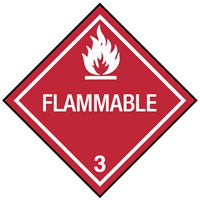
 Print
Print
Chemical Datasheet
ISOPROPYL MERCAPTAN |

|
Chemical Identifiers
| CAS Number |
UN/NA Number |
DOT Hazard Label |
USCG CHRIS Code |
- 75-33-2

|
|
|
|
| NIOSH Pocket Guide |
International Chem Safety Card |
|
none
|
none
|
NFPA 704
data unavailable
General Description
White liquid with a strong skunk-like odor. (USCG, 1999)
Hazards
Reactivity Alerts
Air & Water Reactions
Highly flammable. Soluble in water.
Fire Hazard
Special Hazards of Combustion Products: Irritating sulfur dioxide gas is formed in fire.
Behavior in Fire: Vapor is heavier than air and may travel to a source of ignition (USCG, 1999)
Health Hazard
Inhalation causes loss of sense of smell, muscular weakness, convulsions, respiratory paralysis. Ingestion causes nausea and vomiting. Contact with eyes or skin causes irritation. (USCG, 1999)
Reactivity Profile
ISOPROPYL MERCAPTAN is incompatible with acids, diazo and azo compounds, halocarbons, isocyanates, aldehydes, alkali metals, nitrides, hydrides, and other strong reducing agents. Reactions with these materials generate heat and in many cases hydrogen gas. May liberate hydrogen sulfide when mixed with an acid.
Belongs to the Following Reactive Group(s)
Potentially Incompatible Absorbents
No information available.
Response Recommendations
Isolation and Evacuation
Excerpt from ERG Guide 130 [Flammable Liquids (Water-Immiscible / Noxious)]:
IMMEDIATE PRECAUTIONARY MEASURE: Isolate spill or leak area for at least 50 meters (150 feet) in all directions.
LARGE SPILL: Consider initial downwind evacuation for at least 300 meters (1000 feet).
FIRE: If tank, rail tank car or highway tank is involved in a fire, ISOLATE for 800 meters (1/2 mile) in all directions; also, consider initial evacuation for 800 meters (1/2 mile) in all directions. (ERG, 2024)
Firefighting
Fire Extinguishing Agents Not to Be Used: Water may be ineffective.
Fire Extinguishing Agents: Dry chemical, alcohol foam, carbon dioxide (USCG, 1999)
Non-Fire Response
Excerpt from ERG Guide 130 [Flammable Liquids (Water-Immiscible / Noxious)]:
ELIMINATE all ignition sources (no smoking, flares, sparks or flames) from immediate area. All equipment used when handling the product must be grounded. Do not touch or walk through spilled material. Stop leak if you can do it without risk. Prevent entry into waterways, sewers, basements or confined areas. A vapor-suppressing foam may be used to reduce vapors. Absorb or cover with dry earth, sand or other non-combustible material and transfer to containers. Use clean, non-sparking tools to collect absorbed material.
LARGE SPILL: Dike far ahead of liquid spill for later disposal. Water spray may reduce vapor, but may not prevent ignition in closed spaces. (ERG, 2024)
Protective Clothing
Self-contained breathing apparatus; goggles or face shield; rubber gloves (USCG, 1999)
DuPont Tychem® Suit Fabrics
No information available.
First Aid
INHALATION: remove victim to fresh air; start artificial respiration and give oxygen if required; observe for signs of pulmonary edema; get medical attention.
INGESTION: give large amount of water and induce vomiting.
EYES or SKIN: flush with water. (USCG, 1999)
Physical Properties
Flash Point:
-30°F
(USCG, 1999)
Lower Explosive Limit (LEL): data unavailable
Upper Explosive Limit (UEL): data unavailable
Autoignition Temperature: data unavailable
Melting Point:
-202.8°F
(USCG, 1999)
Vapor Pressure: data unavailable
Vapor Density (Relative to Air): data unavailable
Specific Gravity:
0.814
at 68°F
(USCG, 1999)
- Less dense than water; will float
Boiling Point:
126.6°F
at 760 mmHg
(USCG, 1999)
Molecular Weight:
76.2
(USCG, 1999)
Water Solubility: data unavailable
Ionization Energy/Potential: data unavailable
IDLH: data unavailable
AEGLs (Acute Exposure Guideline Levels)
No AEGL information available.
ERPGs (Emergency Response Planning Guidelines)
No ERPG information available.
PACs (Protective Action Criteria)
No PAC information available.
Regulatory Information
EPA Consolidated List of Lists
No regulatory information available.
CISA Chemical Facility Anti-Terrorism Standards (CFATS)
No regulatory information available.
OSHA Process Safety Management (PSM) Standard List
No regulatory information available.
Alternate Chemical Names
- I-PROPYLTHIOL
- ISOPROPANETHIOL
- ISOPROPYL MERCAPTAN
- ISOPROPYLTHIOL
- 2-MERCAPTOPROPANE
- 1-METHYLETHANETHIOL
- PROPANE-2-THIOL
- 2-PROPANETHIOL
- 2-PROPYLMERCAPTAN


 Print
Print
